Kitefoiling: Best 2019 Hydrofoils for You
Best 2019 Hydrofoils For You
With the explosion of hydrofoil sports and new designs for 2019, even experienced riders are left with some questions. In this blog, we’ll go in-depth covering the differences between foil options, and discuss how to choose the best foil for you. I’ve done my best to title each section appropriately so you can skip to the point if you are in a hurry. There is a lot of info here so you may want to bookmark it for later reference.
Weight and Price
Weight and price are popular topics when it comes to choosing a hydrofoil, and often move in opposite directions. This means the lighter the product, the higher the price, and vice versa. This is due to the cost of materials and manufacturing processes required to make a quality hydrofoil with a lighter weight. As you can tell from the medium-sized surf foil comparison below, our lightest foils also happen to be the most costly. On the flip side, price decreases significantly as the weight increases.
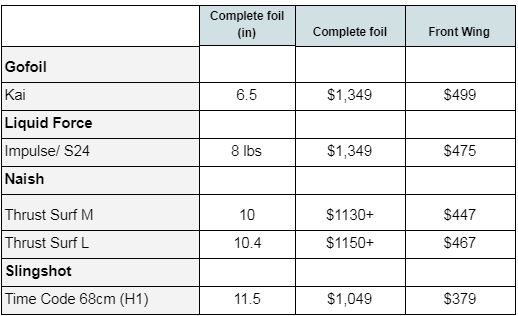
The question is: Which is right for you? For most, this comes down to two factors…
1) Your Current Ability
Your current ability is important to consider, as lighter foils are widely acknowledged for their higher performance capabilities. The lesser weight means the foil accelerates more quickly, and can be maneuvered abruptly to make the most of underpowered situations. This is especially evident in waves, where their positive buoyancy will allow the foil to rise more quickly during pumping actions. Experienced foilers also tend to have their foil care dialed. Full carbon foils require more care, as they are more easily damaged and more costly to replace parts, while aluminum foils tend to be more robust and can roll with mishandling mistakes common with new riders. There are other benefits for new riders on aluminum foils, including price, ballast, and momentum.
Price
When you are just getting into something new, you not as comfortable spending large sums of money on it (although it is quickly justified by the fun you have once you get going). This leads me to drive a $700 van and ride a few $2200+ foil setups. Priorities, my friends, gotta have them!
Ballast
Ballast is an often overlooked benefit of alloy hydrofoils. Like in boats, ballast in your foil setup can add stability for choppy seas and inexperienced riders. Heavier foils, such as the Naish Thrust Surf and Slingshot FSurf and FSUP models, are less twitchy and require more intentional input from the rider. Your minor mistakes as a new rider will have a less noticeable effect on the ride. Additionally, ballast stability is more significant at the lower speeds that newer riders prefer. As you progress into faster speeds, it becomes less apparent.
Momentum
A bit more physics applied to fun, the additional two to three pounds on aluminum foils allows for more momentum. Once moving, heavier foils carry their speed in their the direction they are headed. This means your ride will be less affected by shifty currents and waves; kind of like your Dad’s old Cadillac down a bumpy road.
2) Your Potential Rate of Progression
Everyone has that friend that can learn anything at hyperspeed (and we all envy him/her). When making a choice about which foil is correct for you, it is important to take note of your probable progression rate. This will help you make the correct choice not only for your current ability, but also for your skills down the road. Slower progressing riders will really appreciate the help that the heavier foils provide, while a quick progressing rider might wish that they had chosen an option that will provide them the benefits they will come to appreciate with practice. The good news is that all of these foils are phenomenal! There is no bad choice, just different benefits that come with each.
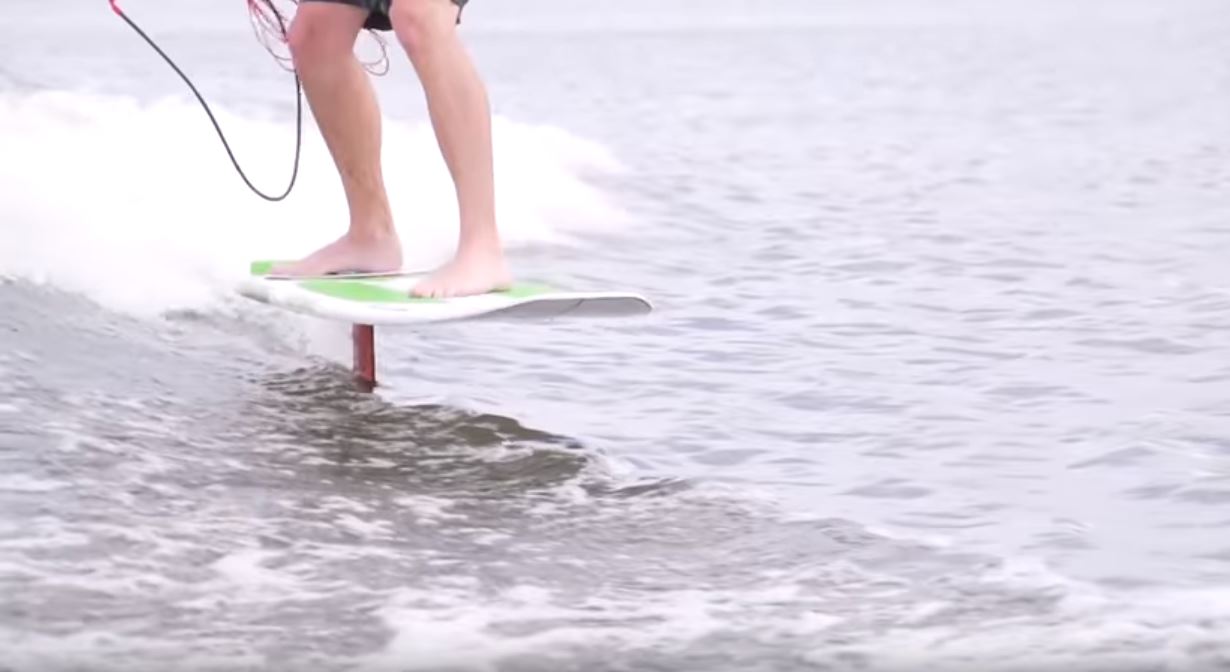
Nate testing out the Space Skate (H4) and Gamma (H2) wings in a #FoilFriday session.
Board Connections
While these foils all cover similar range with their basic design principles and uses, they all go about attaching to the board in similar, yet unique ways. Board connection options include plate mounts, Gofoil Tuttle, or Deep tuttle.
Plate Mounts
Plate mounting, or track mounting as it is sometimes called, is quickly becoming the preferred method of attaching hydrofoils to surfboards, kiteboards, paddle boards, and windsurfers. This is due to their ease of use, adjustability, and durability. All plate mounts are compatible with 90mm tracks found in most boards today.
Gofoil now produces plate mount masts, but will require a plate adapter for their “Gofoil tuttle” models to be used on a 90mm track mount. Liquid Force, Naish, and Slingshot all come standard with this plate style mount, although Naish uses M6 hardware rather than the M8 used by nearly every other brand. Naish and Liquid Force standard plates offer drop-in slots that allow for quick assembly without the need to remove the screws fully from their track nut.
Naish furthers that idea with their new Abracadabra top plate. The Abracadabra top plate uses an aluminum slide in slot and a set screw to allow riders to remove and reinstall the foil more quickly. While this is most useful for those who disassemble their foil for transport, it could also be helpful for people with multiple foils or foilboards. Abracadabra plates require more care. Keeping the track clean from sand, gunk, salt, and scarring is essential for the smooth operation of the system. We find that the brass set screw can also be easily stripped, so you will want to take extra care when using it. Be sure to replace it before it becomes overly damaged. For these reasons, we recommend the standard plate to most riders. It saves weight, money, and when used with the drop in slots, is just a quick attach.
Gofoil Tuttle
The Gofoil Tuttle connection is unique to GoFoil, but can still be found in popular boards such as Amundson, Kalama, and Jimmy Lewis due to the prevalence of Gofoil products in surfing and paddleboarding. It utilizes a “deep tuttle” board finbox, but the mast end features a flat top rather than the angled version common in windsurfing. They cannot be used without modification in a standard Deep Tuttle box installed for windsurfing. This is because they use a different hole pattern due to that flat top. Although not quite as strong or adjustable as the plate mount, the Deep tuttle and Gofoil tuttle boxes have a sleek design that some high end designers prefer.
Deep Tuttle
Popularized by the windsurf industry, the deep tuttle box can be found in a majority of windsurfers past and present. Because of this, many of these foils are adaptable to this style of box. Although not all present in this discussion; Naish, Slingshot, Neil Pryde, and Delta all produce foils or mast adapters that will can be used in a Deep tuttle box.
Wing Designs
This is where things can either get simple or complex, depending on how deep you want to go down the rabbit hole. Let's cover the basics first.
Overall, wings look quite similar. They resemble small airplanes, and are all made of some sort of carbon. They can sometimes be difficult to compare without holding them side by side. This is because they are all built to do basically the same thing; provide lift at a rate of board speed ranging from 5-40 miles per hour, depending on their intention. All of the brands we carry are well established by highly knowledgeable designers, research and development teams, and testing personal. They also happen to be hand picked by our team of foil freaks because of their excellence. This is all said to qualify the statement: "All foils are excellent, each simply has its own design intention, feel, and benefits”.
Hopefully this brief look at the most influential design aspects will help narrow your options and further inform you. If you are aware of your riding style, weight, and ability we should be able to reduce it to just a few product options. From there, budget can be the deciding factor for most. As always, you can simply email, call us at 800.622.4655 or jump on our live chat to explain your personal situation for our best recommendation.
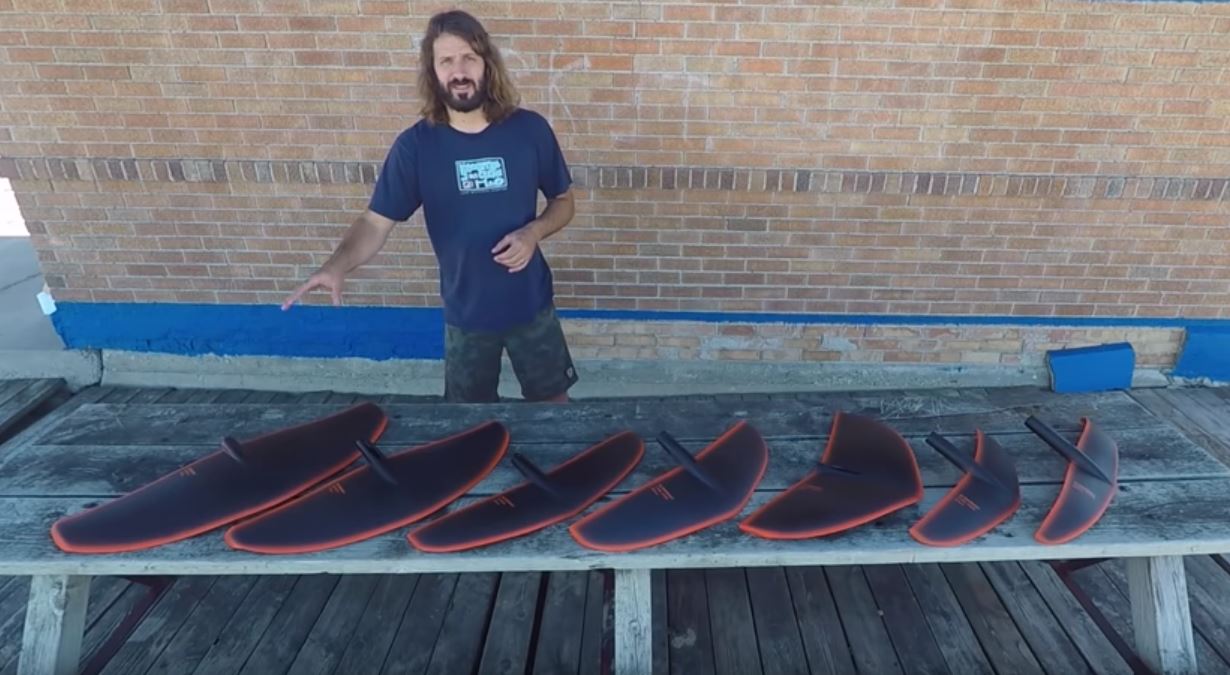
Tucker covers the specs of the new 2019 Slingshot Wings.
Surface area
Foils designs are highly influenced by a number of variables, the most basic and important of which are surface area, aspect ratio, and chord thickness. As you might expect, foils with larger surface area provide more lift. Slower riding speeds or heavier loads will require more lift to sustain flight and to remain stable. Small foils have less drag and friction, which gives them a much higher top speed. Because of this, downwind SUP foilers will prefer wings upwards of 1900 cmsq while kite racers prefer foils with under 600 cmsq. Those being the outliers, most wave and kite foilers will find their happy spot somewhere between 650 and 1600 cmsq, depending on their weight, riding speed, and riding style. Reference the chart below to get a good idea of which might be best for you.
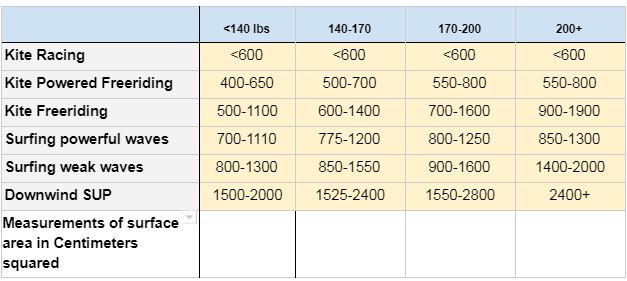
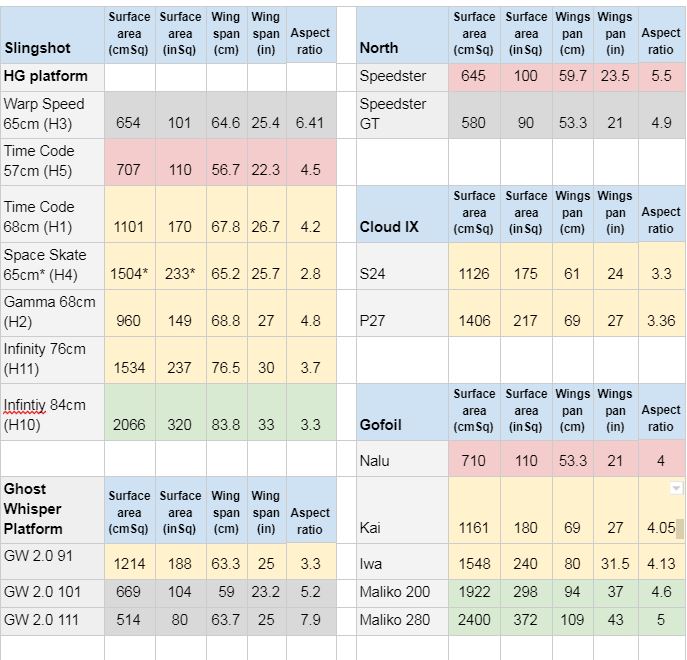
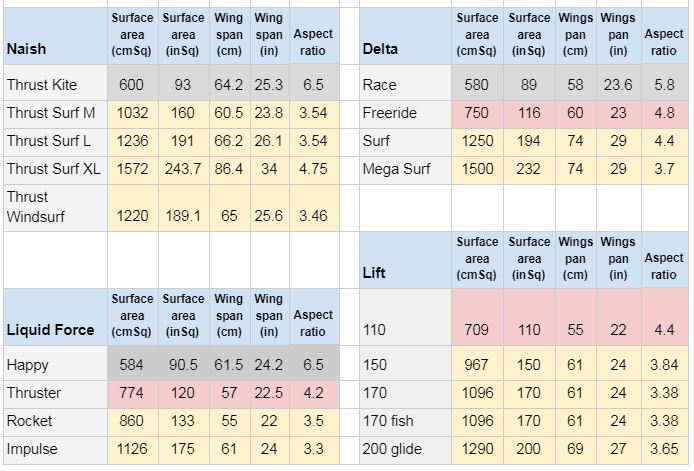
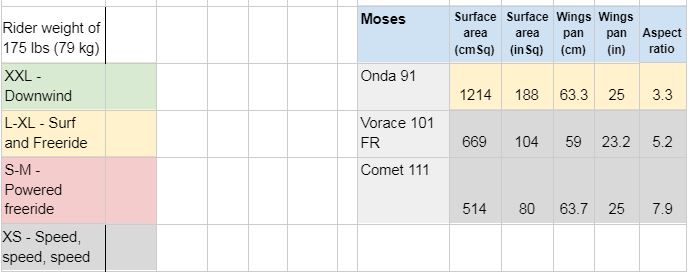
Aspect Ratios
Aspect ratio also plays a major role in the design of foils. The higher the aspect ratio, the higher the top speed and the broader the speed range, especially when compared to designs with similar size and chord thickness. The lower the aspect ratio, the more maneuverable the foil will be. Additionally, low aspect foils accelerate and decelerate more abruptly than high aspect foils.
Wing Thickness
This one is pretty simple. Thicker wings provide more lift, but are also slower due to the larger amount of drag. One can then assume that thinner wings do not provide as much lift, but do have a higher top speed due to their reduced drag. Most designs with the same intention will be similar in thickness. Noting thickness can help you correctly compare their aspect ratio, surface area, and resulting lift. For instance, the Slingshot Time Code 68 (H1) wing has a higher surface area and lower aspect ratio than the Slingshot Gamma (H2) wing. However, the H2 is thicker, and therefore has more lift. Additionally, the H2 has a much shallower anhedral curve.
Anhedral and Dihedral Shapes
Anhedral (downturned) and Dihedral (upturned) curves in wings have a noticeable effect on the feel when turning, as well as the use of the wing’s lift. Anhedral curved wings tend to have the feeling of accelerating through turns, and require a touch more input to initiate said turn. These make up the majority of wing designs on the market today, with some familiar examples being the Liquid Force Impulse, Naish Thrust Surf, Slingshot Time Code wings, and GoFoil products. Comparatively, Dihedral wings, sometimes called “gull wings,” produce a rocky feeling turn from edge to edge, similar to how a V concave works in surfboards. A good exaggerated example is the Slingshot Space Skate wing, featured on the 2019 FKite. These Dihedral wings require less input from the riders to initiate the turn, and have the feeling of slowing down through the turn. This requires riders to ride from edge to edge. They also tend to return to center more naturally, requiring little to no input to do so. Dihedral wings are frequently used in conjunction for front and rear wings to produce a blend of the two styles.
Any change in the wing’s shape from flat will decrease the lift slightly, due to the lift being projected in a direction other than vertical. The most exaggerated example would be the Naish Thrust Surf’s bent wingtips. The large, abrupt wingtip bend removes 10-15% of it’s lift when compared to similarly shaped foils. It does, however, give a unique locked-in feel to these products and has created a cult following as a result.
Unique Brand Features
Cabrinha
- 2019 yet to be released, big things expected soon
- 2018 foils feature unique sandwich-style wings
- Highly portable
Cloud IX
- Carbon Fuselage and wings
- Multiple rear wing mounting positions for a progression-friendly setup
- Two wing offerings
- Compatible with Liquid Force foil products
Delta
- Deep tuttle and plate systems
- Custom made by hand
- Thinner than most designs of the same size for a higher top speed
GoFoil
- Highly durable and light carbon construction
- New for 2019, both Gofoil tuttle and Plate mounts in 24.5”, 28.5”, and 29.5” sizes
- New Gofoil adapter plate available for Gofoil tuttle models
- Must buy all wingsets as a complete foil for easy fitment. Contact us to talk about additional wings and fitment.
Lift
- New for 2019, 200 glide wing and 170 fish wing
- Two piece design. One piece fuselage with wings, one piece mast and collar.
- Excellent durability and build quality
- New surf and kite boards for 2019 shaped by Legend Ricky Carroll
Liquid Force
- New Impulse foil for the freeriders. Wings designed by Cloud IX.
- Excellent balance of weight, price, and durability
Moses
- New for MACkite in 2019
- Race proven performance and reliability
- High modulus carbon construction, durable aluminum fuselage
- Made in Italy. Impressive fit and finish.
Naish
- New for 2019. More wing, mast and collar options.
- Redesigned fuselage for a more responsive ride
- Adjustable rear wing pitch to finetune it’s lift/feel
Neil Pryde
- Excellent windsurf foils for deep tuttle boxes
- More excitement expected during the 2019 release. Stay tuned.
DuoTone (formerly North kiteboarding)
- Unique composite injected wings and fuselage for excellent durability
- Compatible with Fanatic SUP wings
- New for 2019, Speedster GT and GT wings for affordable speed
Slingshot / Ride Engine
- Industry leading popularity
- Amazing durability
- 7 wing options starting at $299. Budget friendly versatility.
- GW 2.0 - licensed Moses designs for proven speed performance
Now that you have made it to the end, hopefully you've gained some knowledge and clarity into the world of foils. As always, feel free to reach out to us with any questions in order to fine tune your choice for a purchase that is bound to meet your needs. We are available 7 days a week, love to talk about foils, solve problems, and set new riders up for success.
Recent Posts
-
Kiteboarding | Crafting the Harlem Force Kite with Sustainability and Performance
Unparalleled Performance Meets Unmatched Sustainability The kiteboarding industry is on …24th Apr 2024 -
Duotone Ventis 2025 | What's New?
If you're familiar with Duotone's Ventis, you know its specialty is freeriding in light wind …23rd Apr 2024 -
Duotone Ventis D/LAB 2025 Overview
If you ride in an area with multiple light wind days and need a wing that'll let you get o …23rd Apr 2024



